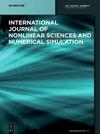Lump solutions to a generalized nonlinear PDE with four fourth-order terms
IF 1.5
4区 工程技术
Q2 ENGINEERING, MULTIDISCIPLINARY
International Journal of Nonlinear Sciences and Numerical Simulation
Pub Date : 2022-05-16
DOI:10.1515/ijnsns-2020-0183
引用次数: 1
Abstract
Abstract A combined fourth-order (2 + 1)-dimensional nonlinear partial differential equation which contains four fourth-order nonlinear terms and all second-order linear terms is formulated. This equation covers three generalized KP, Hirota–Satsuma–Ito, and Calogero–Bogoyavlenskii–Schiff equations as examples, which have physical applications in the study of various nonlinear phenomena in nature. In terms of some settings of the coefficients, a class of lump solutions is constructed by the Hirota bilinear method and the solutions are calculated through the symbolic computation system of Maple. Meanwhile, the relation between the coefficients and the solution is explored. Two special lump solutions are generated by taking proper values for the involved coefficients and parameters, and their dynamic behaviors are studied, as illustrative examples. The primary advantage of the Hirota bilinear method is to transform a nonlinear equation into a bilinear one so that the targeted equation can be easily studied.一类四阶广义非线性偏微分方程的整体解
摘要建立了一个包含四个四阶非线性项和所有二阶线性项的组合四阶(2 + 1)维非线性偏微分方程。该方程以广义KP、Hirota-Satsuma-Ito方程和Calogero-Bogoyavlenskii-Schiff方程为例,在自然界各种非线性现象的研究中具有物理应用。根据系数的某些设置,利用Hirota双线性方法构造了一类块解,并通过Maple的符号计算系统计算了解。同时,探讨了系数与解之间的关系。通过选取合适的系数和参数,得到了两种特殊的块状解,并对其动力特性进行了分析。Hirota双线性方法的主要优点是将非线性方程转化为双线性方程,以便于目标方程的研究。
本文章由计算机程序翻译,如有差异,请以英文原文为准。
求助全文
约1分钟内获得全文
求助全文
来源期刊
CiteScore
2.80
自引率
6.70%
发文量
117
审稿时长
13.7 months
期刊介绍:
The International Journal of Nonlinear Sciences and Numerical Simulation publishes original papers on all subjects relevant to nonlinear sciences and numerical simulation. The journal is directed at Researchers in Nonlinear Sciences, Engineers, and Computational Scientists, Economists, and others, who either study the nature of nonlinear problems or conduct numerical simulations of nonlinear problems.

 求助内容:
求助内容: 应助结果提醒方式:
应助结果提醒方式:


